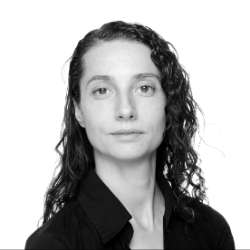More and more museums and galleries are opening their doors to dance. Even though performance is nothing new in art galleries, which sometimes feature them as independent artworks or as opening/closing events for exhibitions, dance is increasingly entering the exhibition circuit in the role of preserved art object. The Barbican, the Hayward Gallery and The Tanks at Tate Modern are only a few of the places that have hosted such reconstructions. It is thus not surprising that to complete the Barbican’s newest exhibition, The Bride and the Bachelors: Duchamp with Cage, Cunningham, Rauschenberg and Johns, the Rambert Dance Company was called to re-enacted Merce Cunnigham’s RainForest (1968).
It is on an elevated space in the middle of the gallery, between Marcel Duchamp’s Fountain (1917) and John Cage’s sound installations, that the Rambert Dance Company has offered its finest dancers for a close-up study. Performed with no real front, the dance was a new experience for most as the space made for a very intimate experience, with the audience gathered around two opposing parts of the performance space. This allowed us to observe the dancers as they waited, stretching and warming up on the side, and also to experience a little thrill. More than one head moved as they performed a breathtaking duet with acrobatic split jumps and lifts only a few centimetres away. At such a distance, it was also possible to see the costumes, light green leotards and tights with holes and stitches so detailed that they would have been lost in the proscenium setting. The perfectly executed restaging was rounded off by an after-show discussion with artistic director Mark Baldwin and the dancers, and this further added to the impression of closeness.
The piece, originally set for a proscenium theatre, is a recollection of “Cunnigham’s childhood memories of the Northwest, and the rainforest in the Olympic Peninsula”. As in most of Cunnigham’s pieces, the dance is stripped to the bare essentials. The dancers are immersed in a soundscape created by the then avant-garde pianist David Tudor that simulates birds and animals. Tudor ingeniously recorded and recycled the sounds of ordinary objects suspended on wires, creating an “ecologically balanced sound system”. Unpredictably floating about the performance space is a facsimile of Andy Warhol’s installation Silver Clouds (1966), helium-filled, silver pillows that Cunningham described as having their own mind. Considered a dramatic piece, simple and quite enigmatic, it manages to evoke the atmosphere of the rainforest with only glimpses of dancers performing a brief solo, not to come back on stage again. They become animals in a forest, chasing, stalking or simply resting, and lions, crocodiles, serpents, dragonflies and exotic birds inhabit the space. The sketches, almost impressionistic scenes, are just long enough to have us wonder – have I really seen that? – with the dancers quickly reverting to a more or less anthropomorphic way of moving.
Despite its apparent abstraction, the piece is closer to reality than the usual neatly organised, harmonic choreography, as the whimsical and unexpected twists recall nature’s own rhythms. Everything looks and sounds deceptively casual, but it is actually highly crafted. The absence of music makes the piece extremely difficult. The dancers have to internalise a tempo and count as the soundscape only provides for some cues. Thus rehearsals are often done in silence. At the same time rebellious balloons float around the space, just to be in the way at the wrong moment during the performance. In this casual but neatly structured order we see the dancers, rigorously blank-faced, becoming sliding serpents, crocodiles quickly moving to the side, or simply resting in a group. Between a lion roaming on all fours for its prey, the sauté battu of a dragonfly flying and a couple in a standard dance pose with the metallic balloon in the background, we ask ourselves: which jungle are we observing? Are these city animals? The question shall not find an answer, as the piece is not supposed to have a specific meaning: it is open to the spectators to create their own interpretations.
Alongside the exhibition, the Barbican has organised an extremely varied programme with many different performance events related to it. It is an occasion to see pieces that are rarely performed and that have been highly influential on the way we perceive art from Dadaist and Absurd pieces to the later development of Samuel Beckett and Robert Wilson. As far as this performance goes, Rambert’s dancers have demonstrated perfect mastery of Cunningham’s difficult and counter-harmonic technique where the lower half of the body is executing balletic movements opposed to the torso’s spinal freedom. Particularly worthy of mention, and only for too brief a glimpse, was the great aerial performance of Pieter Symonds, and Dane Hurst’s emotionally charged interpretation, which was only restricted by the performance space. My only criticism concerns the programming: the event was too short for the number of dancers and the size of the audience. It could easily have been completed with one more piece.


